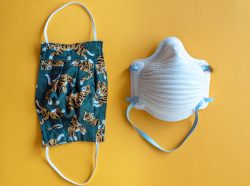 Surgical masks and N95 respirators are examples of personal protective equipment (PPE) which are used to protect the wearer from liquid contamination and airborne particles from contaminating the face. It is important to know the optimal way to prevent airborne transmission. Each type of mask and also cloth face masks serve different functions.
Surgical masks and N95 respirators are examples of personal protective equipment (PPE) which are used to protect the wearer from liquid contamination and airborne particles from contaminating the face. It is important to know the optimal way to prevent airborne transmission. Each type of mask and also cloth face masks serve different functions.
N95 respirators are tested and approved by the NIOSH (National Institute for Occupational Safety and Health). Their intended use and purpose is to protect the wearer from exposure to particles including small particle aerosols and large droplets. They are designed to have a close fit to the face and very effective filtration of particles that are airborne.
The N95 classification means that when exposed to careful testing, the respirator prohibits a minimum of 95% of quite small (0.3 micron) particles that were tested. If fitted properly, the filtration properties of these type respirators exceed those of face masks. However, they do not completely eliminate the risk of illness. Leakage can occur around the edge of the mask when user inhales. N95 respirators are disposable and ideally should be discarded after each patient encounter and/or when the unit no longer forms an effective seal to the face, becomes wet or visibly dirty, breathing becomes difficult, or it becomes contaminated with blood, respiratory or nasal secretions or other bodily fluids from patients.
N95 masks are typically used in healthcare settings. The CDC doesn’t recommend to the public to wear N95 respirators to safeguard themselves against respiratory diseases such as COVID-19. These masks are critical supplies that are primarily reserved for health care workers and first responders as recommended by the CDC.
Surgical masks are disposable, loose fitting accessory that devise a physical barrier between the nose and mouth of the wearer and potential contaminants in the immediate environment. They are typically used for the protection of the wearer from splashed sprays and large particle droplets. They also prevent the spread of possibly infectious respiratory secretions from the wearers to others. They are tested and approved by the FDA.
Surgical masks are loose fitting and can vary in design. However, masks are often flat, rectangular and have folds and/or pleats. The top of the mask can contain a metal piece which can be bent to a person’s nose. Long straight ties or elastic bands help a surgical mask stay in place while being worn – either looped behind the ears or tied behind the head.
While a surgical mask is meant to block large particle splashes, droplets, splatter or sprays that might contain germs (bacteria and viruses), they cannot block or filter particles that are very small in the air that could be carried by sneezes, coughs or certain medical procedures. They do not achieve complete protection from other contaminants and germs because they have a loose fit between the layer of the face mask and face. They are intended for one use only and should be discarded after each patient encounter.
Cloth face coverings many of which can be homemade, only offer a small degree of protection, but the may also help the slow spread of the COVID-19 virus. These type masks are what the CDC is recommending for use by the general public when in public settings.
Face cloths should not be placed on children under the age of 2, people who have breathing difficulties, people who are unconscious, or people who are unable to remove the mask on their own. They should be washed after each use. When removing a person should be careful not to touch their nose, eyes or mouth and hands should be washed immediately after removal.
They can be made from common materials. It should be kept in mind by wearers of these type masks that they can provide a false sense of security. While they do offer some degree of protection, they offer a lot less protection than respirators or surgical masks. One study indicated that homemade face masks may be half as effective as surgical masks and up to 50 times less effective than N95 respirators. However, they are better than not wearing any mask and create some protection especially where a person cannot social distance.





